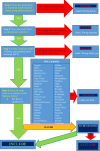Menstrual health needs and educational outcomes among adolescent girls living in countries in sub-Saharan Africa: systematic review protocol
- PMID: 40398941
- PMCID: PMC12097000
- DOI: 10.1136/bmjopen-2024-094613
Menstrual health needs and educational outcomes among adolescent girls living in countries in sub-Saharan Africa: systematic review protocol
Abstract
Introduction: Poor menstrual health and unmet menstrual needs influence several aspects of adolescent girls' lives, including their educational outcomes. However, evidence on menstrual health needs and educational outcomes among these vulnerable girls living in countries across sub-Saharan Africa (SSA) is fragmented and inconclusive. The systematic review aims to explore the association between menstrual health needs and educational outcomes among adolescent girls (10-19 years) living in SSA.
Methods and analysis: Studies (published and unpublished) will be identified from relevant electronic databases including PubMed, CINAHL, ScienceDirect, Google Scholar and LILACS without language restriction from January 2012 to December 2024. A comprehensive set of search terms and their alternate terms, together with the names of countries in sub-Saharan Africa, will be used for running the searches. We will also search Scopus, Web of Science, African Index Medicus, HINARI, African Journals Online, Academic Search Premier, MedRXIV, ProQuest, EBSCO Open Dissertations and reference lists of relevant studies. We will contact experts, identified through authorship of key publications in menstrual health research and recommendations from established research networks, for potentially relevant unpublished studies. All retrieved articles from the electronic databases and grey literature will be collated and deduplicated using Endnote and exported to Rayyan QCRI. The pre-defined eligibility criteria will be followed to screen papers for inclusion in the review. The flow of studies will be reported using the Preferred Reporting Items for Systematic Reviews and Meta-Analyses (PRISMA) flow diagram. Given the anticipated volume of literature to be reviewed, at least two reviewers will independently select studies, extract data and assess the quality of the included studies for risk of bias using the Robbins-E risk of bias assessment tool. Any disagreements will be resolved through discussion between the reviewers. The Joanna Briggs Institute's Sumari Software will be used for citation management. Binary outcomes will be estimated using pooled proportions (for non-comparative studies) and odds ratio (OR) or risk ratio (RR) (for comparative studies), reported with their 95% CIs. The mean difference (MD) will be used for reporting continuous outcomes with their 95% CIs. In the case where different instruments have been used to report means, we will employ standardised mean difference (SMD). Heterogeneity will be assessed graphically for overlapping CIs and statistically using the I2 statistic, and if heterogeneity is detected to be high (>50%), subgroup analysis will be performed to assess the impact of such variation.
Ethics and dissemination: While ethical approval is not required for the systematic review methodology itself, appropriate data sharing agreements and confidentiality protocols will be followed when collecting unpublished data from experts. The findings from this review will be published in a peer-reviewed journal and presented at relevant conferences. Also, the findings will be communicated to local stakeholders (eg, adolescent girls, parents/guardians, school authorities) in appropriate formats and languages to support translation into policy and practice to improve menstrual health and hygiene and education for adolescent girls in sub-Saharan Africa.
Prospero registration number: CRD42024565296.
Keywords: Adolescents; PUBLIC HEALTH; Schools; Systematic Review.
© Author(s) (or their employer(s)) 2025. Re-use permitted under CC BY-NC. No commercial re-use. See rights and permissions. Published by BMJ Group.
Conflict of interest statement
Competing interests: None declared.
Similar articles
-
Folic acid supplementation and malaria susceptibility and severity among people taking antifolate antimalarial drugs in endemic areas.Cochrane Database Syst Rev. 2022 Feb 1;2(2022):CD014217. doi: 10.1002/14651858.CD014217. Cochrane Database Syst Rev. 2022. PMID: 36321557 Free PMC article.
-
Mental health problems in pregnant and postpartum women living with HIV in sub-Saharan Africa: Systematic review and meta-analysis protocol.PLoS One. 2024 Oct 3;19(10):e0308810. doi: 10.1371/journal.pone.0308810. eCollection 2024. PLoS One. 2024. PMID: 39361676 Free PMC article.
-
Obstetric, foetal and neonatal outcomes in adolescent pregnancy in sub-Saharan Africa: Systematic review and meta-analysis protocol.PLoS One. 2025 May 9;20(5):e0323099. doi: 10.1371/journal.pone.0323099. eCollection 2025. PLoS One. 2025. PMID: 40344007 Free PMC article.
-
Malaria vaccine-related adverse events among children under 5 in sub-Saharan Africa: systematic review and meta-analysis protocol.BMJ Open. 2023 Oct 4;13(10):e076985. doi: 10.1136/bmjopen-2023-076985. BMJ Open. 2023. PMID: 37793915 Free PMC article.
-
Menstrual hygiene practice and associated factors among adolescent girls in sub-Saharan Africa: a systematic review and meta-analysis.BMC Public Health. 2023 Jan 6;23(1):33. doi: 10.1186/s12889-022-14942-8. BMC Public Health. 2023. PMID: 36604734 Free PMC article.
References
-
- Oster E, Thornton R. Menstruation, Sanitary Products, and School Attendance: Evidence from a Randomized Evaluation. American Economic Journal: Applied Economics. 2011;3:91–100. doi: 10.1257/app.3.1.91. - DOI
MeSH terms
LinkOut - more resources
Full Text Sources
Medical
Research Materials

